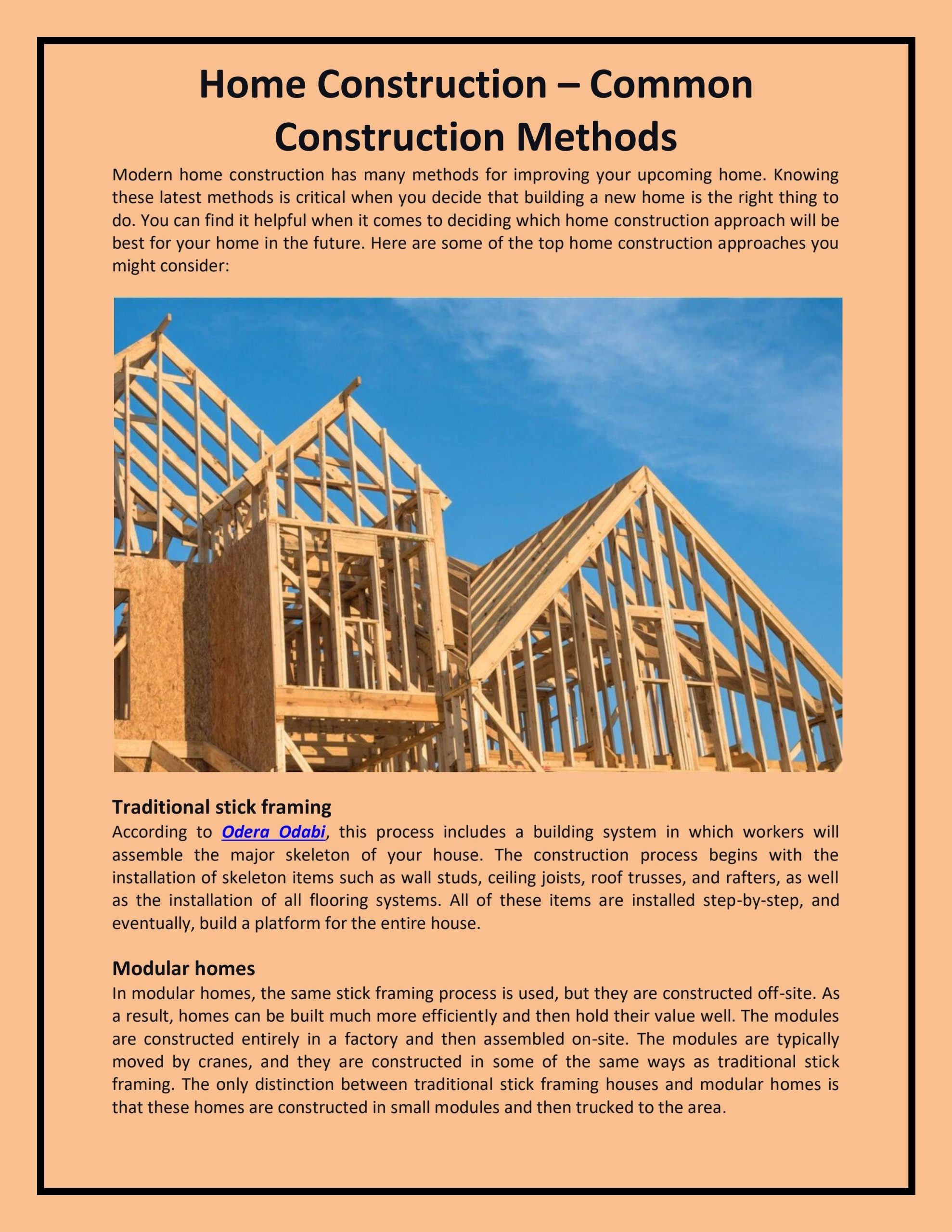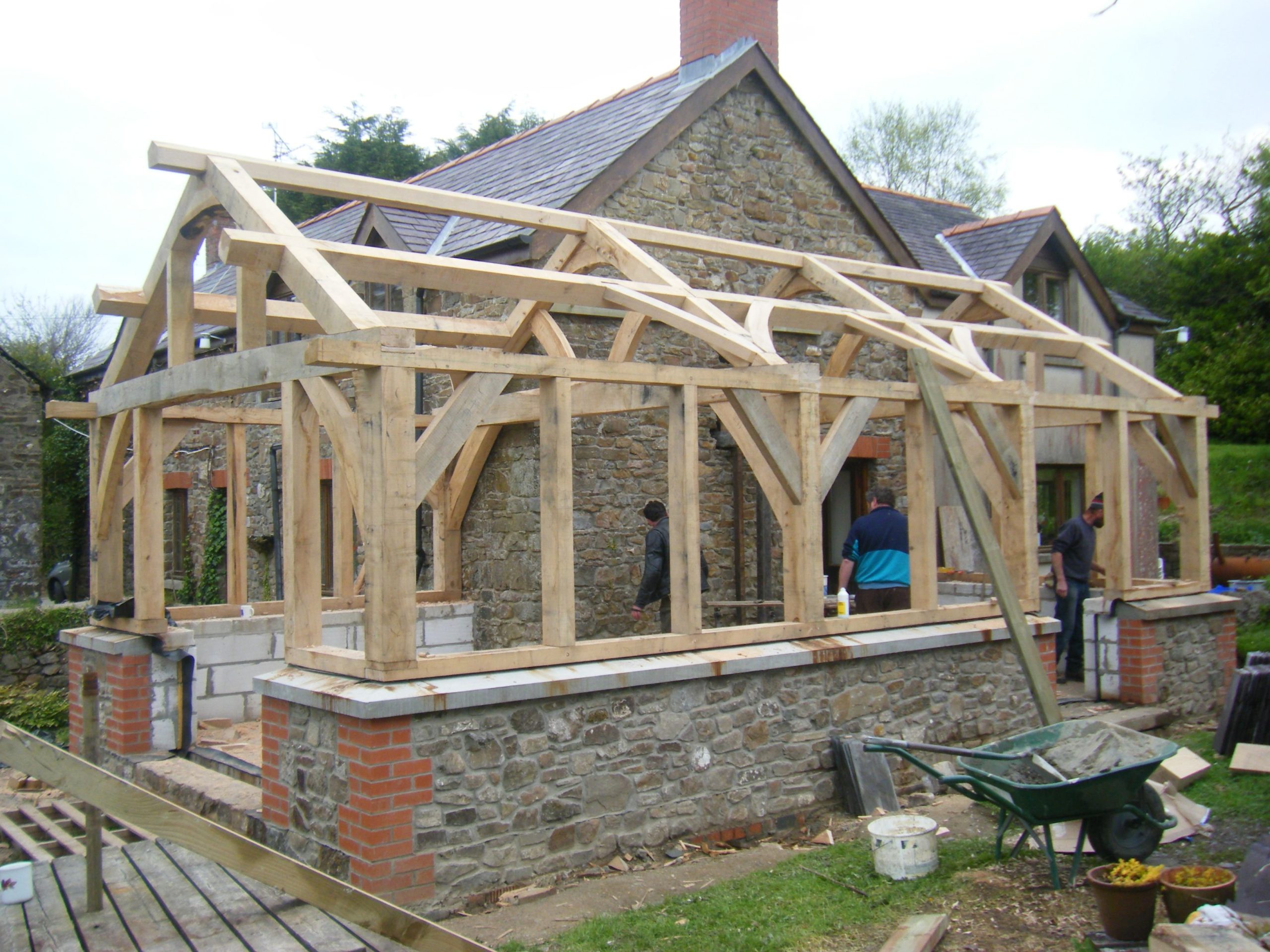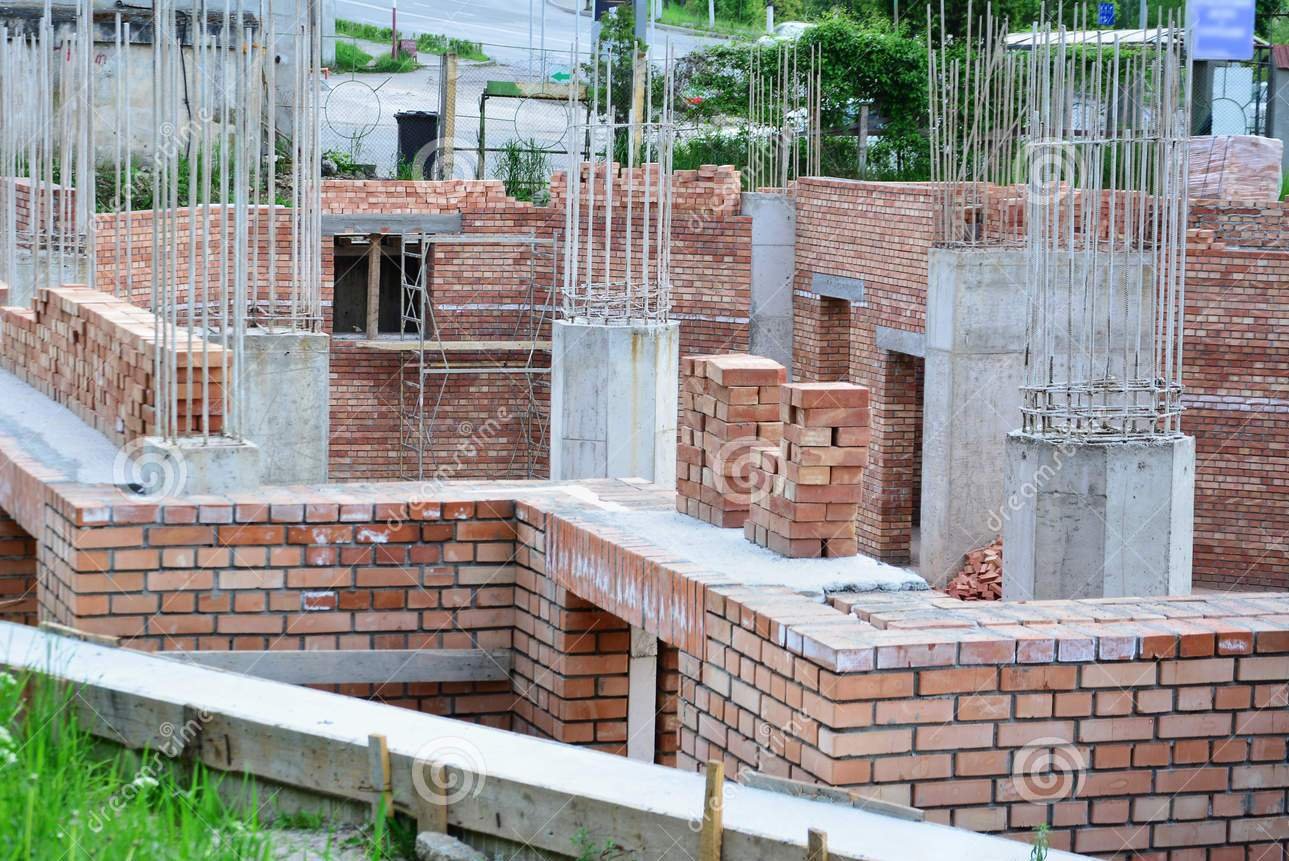Embark on a comprehensive journey through the world of home construction methods in our guide, [- A Comprehensive Guide to Home Construction Methods: Exploring Traditional and Innovative Approaches]. We delve into the intricacies of time-honored techniques like stick framing and cutting-edge approaches such as modular construction, empowering you with the knowledge to make informed decisions for your next building project.
Key Takeaways:
- Traditional Stick Framing:
- Uses wood lumber assembled on-site.
-
Relatively cost-effective and common method.
-
Modular Homes:
- Built in sections off-site and assembled on location.
-
Fast and efficient process, but can be more expensive.
-
Light Gauge Steel:
- Uses steel frames for durability and fire resistance.
-
Lightweight and resistant to pests, but requires specialized skills.
-
Structural Insulated Panels (SIPs):
- Prefabricated panels with insulated cores for energy efficiency.
-
Cost-effective and offers a high level of insulation.
-
Concrete:
- Uses concrete for walls, floors, and roofs.
-
Provides strength and resistance to extreme weather.
-
3D Printing:
- Uses a machine to print construction materials.
- Reduces waste and labor costs, but still in its development stage.
Home Construction Methods

Navigating the labyrinth of home construction methods can be daunting, but understanding each approach’s nuances empowers you to make informed decisions. In this guide, we’ll delve into the intricacies of traditional and innovative methods, highlighting their advantages and potential drawbacks to equip you for a successful construction journey.
Traditional Stick Framing: The Tried-and-True Method
For generations, stick framing has been the cornerstone of home construction. This method involves assembling wooden lumber on-site to create the home’s skeletal structure. Its adaptability and the availability of skilled labor make it a popular choice.
Pros:
– Versatile and customizable
– Cost-effective in many areas
– Familiar to most builders
Cons:
– Labor-intensive, potentially slowing down construction
– Susceptible to moisture damage if not properly sealed
Modular Homes: Building Blocks for Efficiency
Modular homes are constructed in controlled indoor environments using standardized methods similar to stick framing. These prefabricated sections are then transported to the building site for assembly.
Pros:
– Faster construction time
– Precise quality control
– Reduced waste and environmental impact
Cons:
– Limited design flexibility
– May require specialized equipment for transportation and assembly
Light Gauge Steel: STRENGTH in the Spotlight
In light gauge steel framing, galvanized steel beams replace wood lumber. This provides exceptional durability, resistance to fire and pests, and enhanced structural integrity.
Pros:
– Highly durable and long-lasting
– Fire and pest resistant
– Lightweight and easy to transport
Cons:
– Potentially higher material costs
– May require specialized contractors
Structural Insulated Panels (SIPs): Energy Efficiency at Its Finest
SIPs combine insulation and structural support into prefabricated panels, sandwiched between layers of wood or other materials. This innovative approach offers superior energy efficiency and durability.
Pros:
– Excellent insulation and energy efficiency
– Quick and easy to install
– Structurally sound
Cons:
– Can be more expensive than traditional methods
– May require specialized builders
Concrete: The Foundation of Strength and Stability
Concrete construction forms solid walls, floors, and roofs, resulting in robust and weather-resistant structures. Its ability to mold into various shapes offers unique design possibilities.
Pros:
– Durable and long-lasting
– Resistant to weather and natural disasters
– Versatile and customizable
Cons:
– Time-consuming and labor-intensive
– Can be more expensive than other methods
3D Printing: The Future of Construction
3D printing technology uses machines to layer materials, such as concrete or plastic, to create complex structures. This innovative method has the potential to revolutionize construction, reducing waste and labor costs.
Pros:
– Faster and more efficient construction
– Reduced waste and environmental impact
– Potential for complex and innovative designs
Cons:
– Still in its early stages of development
– Material costs may be high
– Limited design flexibility for now
Looking for quality and affordable construction materials? Check out our comprehensive selection of home construction materials, designed to meet your every construction need. Discover reliable insurance policies tailored specifically for your home construction project. Protect your investment and ensure peace of mind with our home construction insurance.
Cost Implications of Different Home Construction Methods

Analyzing the cost implications of different home construction methods is pivotal for informed decision-making. Let’s explore 12 key factors influencing the total cost of on-site vs. off-site construction:
Material Costs:
On-site construction typically involves sourcing materials from local suppliers. Off-site construction, utilizing factory-produced components, may streamline material procurement and bulk discounts.
Labor Costs:
On-site construction requires skilled labor for fabrication and assembly. Off-site construction reduces on-site labor costs through controlled factory processes.
Overhead Costs:
On-site construction incurs costs related to site preparation, utilities, and project management. Off-site construction may shift these costs to the manufacturing facility.
Quality Costs:
On-site construction can be influenced by weather conditions and human error. Off-site construction offers greater quality control through factory-controlled environments.
Warranty Costs:
Both on-site and off-site construction companies provide warranties. Assessing warranty coverage and costs is crucial.
Environmental Costs:
On-site construction generates waste from materials and construction activities. Off-site construction often optimizes material usage and minimizes waste.
Productivity Costs:
On-site construction is subject to weather delays and site constraints. Off-site construction provides a controlled environment that enhances productivity.
Time Costs:
On-site construction schedules can be protracted by weather, material delays, and labor shortages. Off-site construction offers faster construction times.
Flexibility Costs:
On-site construction allows for design modifications during construction. Off-site construction may have less flexibility in design changes.
Risk Costs:
On-site construction may face risks such as weather damage or project delays. Off-site construction reduces these risks through controlled factory environments.
Scheduling Costs:
Coordinating subcontractors and material deliveries can be complex in on-site construction. Off-site construction streamlines scheduling through factory production.
Financing Costs:
Construction loans may vary based on the construction method and project timeline. Understanding financing implications is essential.
Key Takeaways:
- Total cost analysis should include all 12 factors, as each method has different cost implications.
- Off-site construction often offers advantages in material, labor, and quality costs, while on-site construction provides greater design flexibility.
- Environmental costs and productivity considerations should be factored in as well.
- It’s essential to weigh the benefits and drawbacks of each method carefully to make an informed decision for your specific project.
Citations:
Factors to consider when choosing a home construction method
Building a home is a significant investment, and choosing the right construction method is crucial. With various options available, each with its advantages and disadvantages, it’s essential to consider several factors to make an informed decision.
Project Complexity and Timeline
The complexity of your home design will influence the construction method. Traditional stick framing is versatile and suitable for complex designs, but it requires more labor and time. Modular homes, on the other hand, offer faster construction with less on-site labor, making them ideal for simpler designs.
Budget and Cost Control
Construction costs vary depending on the method you choose. Stick framing is generally more cost-effective, while modular homes can be more expensive due to factory production costs. However, modular homes offer potential savings in labor and reduced waste.
Sustainability and Energy Efficiency
Consider the environmental impact and energy efficiency of different construction methods. Concrete and SIPs provide excellent insulation, reducing energy consumption and costs. Light gauge steel is durable and eco-friendly, while modular homes minimize waste and pollution during construction.
Flexibility and Customization
If you desire a highly customized home, stick framing offers greater flexibility in design and layout. Modular homes have limitations in design customization, but they can still meet specific requirements within the available options.
Labor Availability and Expertise
The availability of skilled labor can impact your choice of construction method. Stick framing requires experienced carpenters, while modular homes rely on specialized factory workers. Consider the local labor market and the accessibility of skilled professionals.
Quality Control and Warranty
The construction method you choose can affect the quality and durability of your home. Stick framing requires careful craftsmanship and attention to detail, while modular homes benefit from controlled factory conditions and standardized processes. Check the warranties offered by different builders to ensure the quality of your investment.
Key Takeaways:
- Consider project complexity and timeline to determine the appropriate method.
- Set a budget and explore cost implications before making a decision.
- Prioritize sustainability and energy efficiency for long-term savings.
- Decide between flexibility and customization based on your design preferences.
- Factor in labor availability and expertise to ensure a smooth construction process.
- Seek quality control measures and warranties to safeguard your investment.
Relevant URL Sources:
Choosing the Best Construction Project Delivery Method: A Comprehensive Guide
Selection of Construction Methods for Construction Projects: A Review
Emerging trends and innovations in home construction techniques
In today’s fast-paced world, advanced technologies have touched every aspect of our lives, including the way we build our homes. Gone are the days of traditional construction methods; innovative techniques are transforming the industry, assuring quicker construction, increased affordability, and improved sustainability.
Key Takeaways:
- Building Information Modeling (BIM) integrates digital representations of a building’s physical and functional characteristics to enhance project planning, coordination, and visualization.
- Virtual Reality (VR) offers immersive experiences, enabling architects, engineers, and contractors to virtually walk through and interact with building designs before construction begins.
- Drones provide aerial insights, facilitating site inspections, progress monitoring, and safety assessments.
- 3D printing leverages advanced technology to produce construction components, reducing waste and construction time.
- Artificial Intelligence (AI) automates processes, predicts outcomes, and assists in decision-making, enhancing project efficiency and safety.
- Robotics empowers construction workers with assistive technologies, minimizing repetitive tasks and promoting workplace safety.
- The Connected Jobsite integrates various technologies to optimize communication, collaboration, and data management, revolutionizing project execution.
Benefits of Emerging Construction Techniques
- Enhanced Efficiency: Technology-driven processes streamline construction, reducing time and labor requirements.
- Improved Accuracy: Digital tools ensure precision in design and execution, minimizing errors and rework.
- Increased Productivity: Automation and robotics optimize workflows, boosting productivity and project completion speed.
- Cost Savings: Advanced techniques reduce material waste, minimize labor costs, and optimize resource allocation.
- Sustainability: Green building practices and innovative materials promote energy efficiency, reduce environmental impact, and enhance occupant well-being.
Conclusion
The construction industry is on the cusp of a technological revolution. Emerging trends and innovations in home construction techniques promise to transform how we design, build, and manage our built environment. By embracing these advancements, we can create homes that are more sustainable, affordable, and tailored to our evolving needs.
Relevant URL Sources:
- Top 27 Emerging Trends In Construction Technology To Watch In 2024
- 19 New Construction Technologies: 2023 Trends
FAQ
Q1: What are the key differences between traditional stick framing and modular homes?
A1: Traditional stick framing involves assembling wood lumber on-site to create the home’s skeleton, while modular homes are built indoors using the same methods as stick framing but off-site in a controlled environment.
Q2: Which building method offers better cost efficiency: on-site or off-site construction?
A2: To determine the total cost efficiency, twelve factors should be considered: material costs, labor costs, overhead costs, quality costs, warranty costs, environmental costs, productivity costs, time costs, flexibility costs, risk costs, scheduling costs, and financing costs.
Q3: How does Building Information Modeling (BIM) enhance home construction projects?
A3: BIM provides enhanced project visualization, improved collaboration among stakeholders, and increased accuracy in design and construction.
Q4: What are the advantages of using drones in home construction?
A4: Drones offer aerial insights for site inspections, progress monitoring, and documentation, enhancing efficiency and safety.
Q5: How can Artificial Intelligence (AI) benefit home construction?
A5: AI automates processes, predicts outcomes, and improves decision-making by analyzing data and identifying patterns, optimizing project planning and execution.
- Small Corner Kitchen Ideas: Maximize Style In Tight Spaces - January 1, 2026
- Kitchen Counter Corner Ideas: Style Your Awkward Angles Now - December 31, 2025
- Best Finish for Butcher Block Countertops: Choosing the Right Option - December 30, 2025










